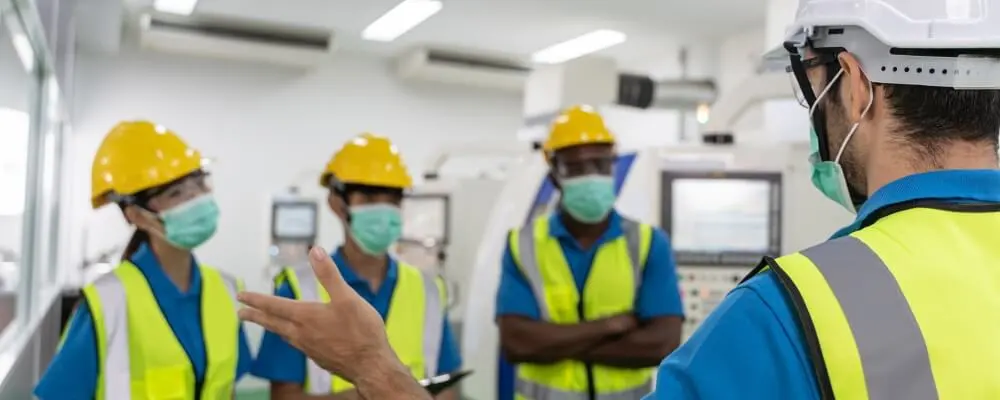In today’s fast-paced work environments, it’s crucial to prioritize the safety and well-being of employees. No matter the job, whether it involves operating heavy machinery, handling chemicals, or ensuring an ergonomic office setup, there are always potential hazards. Our blog post provides a comprehensive guide to workplace safety. It covers various aspects of safety training, including different types, core purposes, and actionable tips for effective training sessions. This guide is a valuable resource for both employers and employees.
As we navigate this essential topic, we’ll underscore the significance of fostering a safety culture, highlighting how it protects employees and contributes to an organization’s overall success and efficiency. Dive in to equip yourself with the knowledge and tools essential for a safer, more productive workplace.
Workplace Safety Training
Workplace Safety Training refers to educating and training employees about the hazards they may encounter in their work environment and how to safely handle or avoid them. The primary goal of this training is to minimize the risk of job-related accidents, injuries, and illnesses. This training is crucial for protecting employees’ well-being and promoting efficient, uninterrupted operations within an organization.
Several elements encompass Workplace Safety Training:
- Awareness of Hazards: Employees are taught to recognize potential dangers, from heavy machinery to toxic chemicals, and even ergonomic risks like repetitive stress injuries.
- Safe Practices and Protocols: Training provides guidelines and procedures to ensure tasks are performed safely. This can range from the correct way to lift heavy objects to protocols for handling hazardous materials.
- Emergency Procedures: In case of unforeseen incidents like fires, power outages, or chemical spills, employees are taught how to respond quickly and safely to minimize damage and potential injuries.
- Use of Personal Protective Equipment (PPE): Depending on the job role, employees are trained to use and maintain safety gear like helmets, goggles, gloves, and respirators.
- Legal and Regulatory Compliance: Many jurisdictions have laws and regulations about workplace safety. Training ensures that employees and employers are aware of and comply with these rules.
- Continuous Learning: Workplace environments, equipment, and procedures can evolve. Safety training is ongoing, with regular updates and refresher courses to address new risks and prevention methods.
The importance of Workplace Safety Training cannot be overstated. It protects employees from harm and fosters a safety culture within the organization, leading to increased productivity, morale, and overall operational efficiency.

Purpose of Workplace Safety Training
Workplace safety training aims to educate employees about potential hazards, risks, and safe practices within their work environment. The primary goal of workplace safety training is to ensure the well-being of employees by minimizing accidents, injuries, and illnesses while promoting a safety culture. Here are some key purposes of workplace safety training:
1. Reduce Accidents and Injuries
Workplace safety training ensures employees are well-versed in recognizing potential hazards and implementing preventive measures. A comprehensive understanding of safety protocols allows employees to navigate their work environments more cautiously, leading to fewer mishaps.
When workers know how to handle machinery properly, understand the importance of personal protective equipment, or can identify hazardous substances, they are less likely to become involved in accidents. Thus, proper training acts as a proactive approach to safeguard the well-being of every individual in the workplace.
2. Legal Compliance
Across the globe, various governments and jurisdictions have established rules and regulations to ensure worker safety. These regulations often stipulate mandatory safety training programs, the use of protective equipment, and adherence to specific operational protocols.
Organizations that fail to provide requisite safety training may face legal consequences, including fines or operational shutdowns. Ensuring that employees undergo thorough safety training fulfills a moral responsibility towards them and ensures that the organization remains compliant with local and international laws.
3. Promote a Safety Culture
Beyond the tangible benefits of fewer accidents and compliance with the law, workplace safety training inculcates a culture where safety becomes a core value. This means that safety isn’t merely a checklist or a one-off training session but becomes an integral part of the organization’s ethos. Employees start to recognize the significance of safety and prioritize it, looking out for themselves and their colleagues.
Over time, this safety culture can become self-sustaining, with senior employees passing down knowledge and habits to newer team members, fostering a work environment where everyone feels responsible for each other’s safety.
4. Improve Employee Morale
Knowing that their well-being is a priority for their employer can profoundly impact employees’ morale. When workers recognize that they have the knowledge and tools to operate safely, it builds trust in the organization and confidence in their abilities.
This confidence often translates into higher job satisfaction and increased productivity. Employees who believe their safety is valued are likelier to be engaged, dedicated, and loyal to the company.
5. Reduce Costs
On the surface, investing in comprehensive safety training might seem an added expense for organizations. However, in the long run, the financial benefits of such training become evident. A reduction in workplace accidents means fewer medical bills, reduced downtime due to injured employees, and fewer compensation claims.
Additionally, by preventing mishaps, companies can avoid costly damage to machinery or equipment. Thus, ensuring rigorous safety training can lead to significant financial savings, underscoring that investing in safety is not only ethically right but also economically sound.

Types of Workplace Safety Training
There are several types of workplace safety training that organizations can provide to ensure the well-being of their employees and promote a safe working environment. The specific types of training may vary based on the industry, job roles, and potential hazards present in the workplace. Here are some common types of workplace safety training:
1. General Safety Training
This foundational training covers the essential safety practices that every employee should know, regardless of their specific role or industry. It introduces basic protocols such as emergency evacuation procedures, which detail how employees should respond during emergencies like fires or natural disasters.
Additionally, it encompasses first-aid training, ensuring that employees understand how to provide immediate medical assistance until professional help arrives. This kind of training fosters a baseline safety consciousness in the workplace.
2. Hazard Communication
Exposure to chemicals can pose significant risks in many workplaces. Hazard Communication training educates employees about these chemicals, ensuring they recognize and understand their potential dangers.
A crucial component of this training involves the Material Safety Data Sheets (MSDS), which provide detailed information about specific chemicals, including their properties, potential hazards, and safety precautions. Employees are taught how to interpret this data, ensuring they know how to safely handle, store, and dispose of hazardous materials.
3. Equipment Safety Training
Every piece of machinery or equipment in the workplace, from a simple office printer to complex industrial machinery, comes with its own set of operational guidelines and safety precautions. This training ensures that employees understand these guidelines.
By learning how to operate, clean, and maintain specific equipment correctly, employees can prevent malfunctions, reduce wear and tear, and, most importantly, avoid accidents related to equipment misuse.
4. Ergonomic Training
Ergonomics focuses on designing workspaces best to complement the human body’s capabilities and limitations. Ergonomic training educates employees on setting up their work environment to reduce the risk of strain, discomfort, or injury.
This might involve adjusting chair height, ensuring proper posture, or arranging tools and equipment within easy reach. Proper ergonomic practices can help prevent musculoskeletal disorders arising from prolonged, repeated tasks or poor posture.
5. Electrical Safety Training
Electricity is a common yet potentially hazardous element in many workplaces. This training caters to those who work directly with electrical systems or around them. It emphasizes the dangers associated with electricity, such as electric shocks or fires. It provides guidelines on safe practices, like ensuring tools are properly grounded and avoiding water near electrical outlets.

6. Fire Safety Training
Fires can be devastating in a workplace setting, causing property damage, injuries, or even loss of life. Fire safety training equips employees with knowledge of preventive measures to reduce the risk of fires.
Additionally, it teaches them how to respond effectively in case a fire does break out, which might include using fire extinguishers, understanding fire alarm signals, and knowing evacuation routes.
7. Fall Protection
Working at heights significantly increases the risk of falls, which can lead to severe injuries or fatalities. Fall protection training is especially vital for workers in sectors like construction, where elevated work is standard.
Employees learn about safety harnesses, netting, and other protective equipment, understanding when and how to use them to ensure they remain safe while working off the ground.
8. Lockout/Tagout
Heavy machinery and equipment can pose risks even when not operational, especially during maintenance or repair. The lockout/tagout procedures ensure that machinery is turned off and cannot be accidentally turned back on during maintenance.
This training teaches employees how to effectively “lock” equipment in an off-state and “tag” it with warnings, thereby preventing accidental startups that could lead to injuries.
9. Personal Protective Equipment (PPE) Training
PPE is gear that workers wear or use to protect themselves from specific hazards present in their workplace. This could range from helmets in construction sites to gloves in chemical labs or respirators in environments with poor air quality.
This training educates employees on the importance of PPE, ensuring they know how to select the right equipment, wear it correctly, and maintain it to ensure it offers maximum protection.
10. Confined Space Entry
Some jobs require workers to enter “confined spaces,” which have limited openings for entry and exit and are not intended for prolonged human occupancy. These spaces can have dangerous atmospheres, posing risks like toxic fumes or a lack of oxygen.
Training in this area ensures that workers know the risks associated with confined spaces and are equipped with knowledge and tools, like ventilation systems or gas monitors, to operate safely within them.
11. Specialized Training
Certain industries come with unique risks and require tailored safety training. For instance, the mining industry might have training specific to the dangers of underground work, while the healthcare industry would have protocols around patient handling and infectious disease control.
These specialized trainings ensure that employees in high-risk sectors are adequately prepared to handle the specific challenges they might face.

Effective Tips for Workplace Safety Training
Creating effective workplace safety training requires careful planning and execution. Here are some tips to ensure that your safety training programs are successful:
1. Regularly Update Training Material
Workplace safety is dynamic, with new methods, tools, and regulations emerging. It’s essential to stay updated with these changes to offer employees the latest information. Regularly revising and updating training material ensures that workers are not relying on outdated or obsolete practices and are fully prepared to tackle contemporary challenges they might face.
2. Engage Employees
The effectiveness of any training program hinges on its ability to capture and retain the attention of its participants. The training can be more engaging through interactive workshops, role-playing, and simulations. These hands-on techniques allow employees to participate actively, fostering a deeper understanding of the material and its practical applications in their daily tasks.
3. Use Real-life Examples
Abstract concepts, while valuable, can sometimes be hard to grasp. Introducing real stories or case studies from within the industry can make these ideas more tangible. When employees hear about real incidents, their effects, and how they were handled, it creates a sense of relatability and urgency, reinforcing the importance of adhering to safety guidelines.
4. Repeat and Reinforce
Safety isn’t something that can be fully comprehended in a single session. Periodic refreshers are essential to reinforce crucial concepts and ensure that employees retain the knowledge they’ve acquired. This repetition ensures that safety guidelines remain in their minds, promoting consistent, safe behavior.
5. Tailor Training to the Audience
Not all jobs carry the same risks. Machine operators and office administrators face different challenges and potential hazards. Therefore, it’s vital to ensure that safety training is tailored to each role’s specific needs and risks. Customizing the training content ensures relevance and applicability, making it more effective.

6. Encourage Feedback
The best way to gauge the effectiveness of a training program is to hear directly from those who underwent it. Encouraging employees to provide feedback can offer valuable insights into areas that might need improvement, topics that need more emphasis, or methods that are particularly effective.
7. Assess Understanding
It’s not enough to merely present information; it’s vital to ensure that it’s been understood. Integrating quizzes, tests, or hands-on demonstrations within or after the training sessions can help gauge the comprehension levels of participants. These assessments can highlight areas needing further explanation or emphasis in future sessions.
8. Invest in Quality Trainers
The content is just one part of effective training; the delivery is equally important. Investing in skilled trainers with deep knowledge of the subject matter and the ability to effectively communicate complex ideas can make a significant difference. Their expertise, passion, and teaching methods can influence how well the information is received and retained.
9. Embrace Technology
With the advent of digital platforms and immersive technologies, the possibilities for training have expanded dramatically. E-learning platforms offer flexibility, allowing employees to learn at their own pace. Virtual reality (VR) and augmented reality (AR) can provide immersive experiences, simulating real-world scenarios in a controlled environment. Leveraging these technologies can enhance the training experience and improve comprehension.
10. Consistently Review and Improve
Safety procedures and training methods shouldn’t be static. Regularly reviewing them in light of new research, feedback, and technological advancements ensures they remain effective and relevant. This ongoing commitment to improvement underscores an organization’s dedication to ensuring the utmost safety of its employees.
Conclusion
Workplace Safety Training stands as a cornerstone of organizational success and employee well-being. As we’ve explored the various types of safety training, delved into its primary purposes, and armed ourselves with effective strategies, it’s evident that prioritizing safety goes beyond mere regulatory compliance. It’s about creating a culture where each individual feels valued, protected, and empowered to contribute their best.
Organizations can improve their safety measures and boost employee morale and productivity by utilizing the essential elements detailed in this discussion. Safety is an integral part of any successful business, woven intricately into every operation to create a strong, efficient, and harmonious work environment for all.

